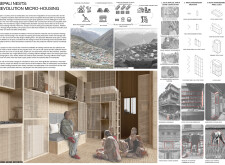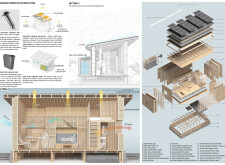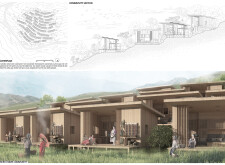5 key facts about this project
### Overview
The "Nepali Nests: Revolution Micro-Housing" project addresses the pressing housing needs in Nepal, particularly emphasizing solutions for regions affected by seismic activity. By focusing on an approach that is culturally sensitive and environmentally sustainable, the design seeks to facilitate resilient communities while utilizing local resources and materials for construction.
### Sustainable Material Utilization
Central to the design are sustainable materials such as bamboo, which is both abundant and structurally robust, and thus plays a key role in both the structural and aesthetic aspects of the micro-housing units. Wood is extensively used for interior finishes, bringing warmth and enhanced structural support, while stone is employed for foundational stability against potential seismic events. The roofs are constructed with durable dark grey tiles, reflecting regional architectural traditions and serving practical purposes in rainwater management. Additionally, solar panels are integrated into the design to promote renewable energy usage, exemplifying the project's commitment to environmental responsibility.
### Spatial Efficiency and Community Interaction
The interior of each micro-home is designed for optimal usability within a limited footprint. Multi-functional spaces are a prominent feature, accommodating adaptable furniture that supports various activities. Specialized closet systems maximize storage capacity for both personal items and agricultural tools, ensuring efficient use of space. The kitchen layout is intentionally designed to facilitate both cooking and social interaction among residents. Enhanced natural light and ventilation are achieved through strategically placed skylights and windows, contributing to indoor comfort and reducing dependency on artificial lighting. Furthermore, the overall layout promotes community engagement, with the arrangement of micro homes encouraging social interaction among residents, which is crucial for community recovery and cohesion.






















































